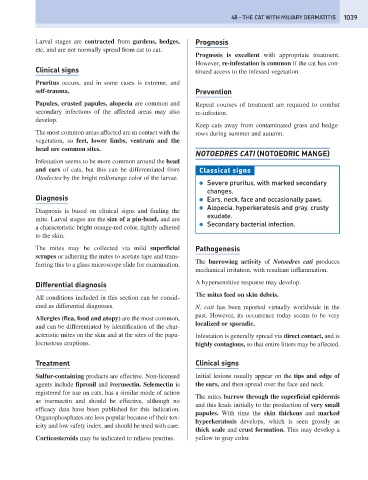Page 1047 - Problem-Based Feline Medicine
P. 1047
48 – THE CAT WITH MILIARY DERMATITIS 1039
Larval stages are contracted from gardens, hedges, Prognosis
etc, and are not normally spread from cat to cat.
Prognosis is excellent with appropriate treatment.
However, re-infestation is common if the cat has con-
Clinical signs tinued access to the infested vegetation.
Pruritus occurs, and in some cases is extreme, and
self-trauma. Prevention
Papules, crusted papules, alopecia are common and Repeat courses of treatment are required to combat
secondary infections of the affected areas may also re-infestion.
develop.
Keep cats away from contaminated grass and hedge-
The most common areas affected are in contact with the rows during summer and autumn.
vegetation, so feet, lower limbs, ventrum and the
head are common sites.
NOTOEDRES CATI (NOTOEDRIC MANGE)
Infestation seems to be more common around the head
and ears of cats, but this can be differentiated from Classical signs
Otodectes by the bright red/orange color of the larvae.
● Severe pruritus, with marked secondary
changes.
Diagnosis ● Ears, neck, face and occasionally paws.
● Alopecia, hyperkeratosis and gray, crusty
Diagnosis is based on clinical signs and finding the
exudate.
mite. Larval stages are the size of a pin-head, and are
● Secondary bacterial infection.
a characteristic bright orange-red color, tightly adhered
to the skin.
The mites may be collected via mild superficial Pathogenesis
scrapes or adhering the mites to acetate tape and trans-
The burrowing activity of Notoedres cati produces
ferring this to a glass microscope slide for examination.
mechanical irritation, with resultant inflammation.
Differential diagnosis A hypersensitive response may develop.
The mites feed on skin debris.
All conditions included in this section can be consid-
ered as differential diagnoses. N. cati has been reported virtually worldwide in the
past. However, its occurrence today seems to be very
Allergies (flea, food and atopy) are the most common,
localized or sporadic.
and can be differentiated by identification of the char-
acteristic mites on the skin and at the sites of the papu- Infestation is generally spread via direct contact, and is
locrustous eruptions. highly contagious, so that entire litters may be affected.
Treatment Clinical signs
Sulfur-containing products are effective. Non-licensed Initial lesions usually appear on the tips and edge of
agents include fipronil and ivermectin. Selemectin is the ears, and then spread over the face and neck.
registered for use on cats, has a similar mode of action
The mites burrow through the superficial epidermis
as ivermectin and should be effective, although no
and this leads initially to the production of very small
efficacy data have been published for this indication.
papules. With time the skin thickens and marked
Organophosphates are less popular because of their tox-
hyperkeratosis develops, which is seen grossly as
icity and low safety index, and should be used with care.
thick scale and crust formation. This may develop a
Corticosteroids may be indicated to relieve pruritus. yellow to gray color.

